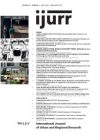Álvaro Sevilla-Buitrago presents a strong thesis: that land-use planning, even in the early capitalist period of the eighteenth century, was the chosen instrument for the destruction of ‘publicity’ among the lower classes. Initially directed against the peasants using commonly held land in rural England, planning destroyed the communal life of the urban working class and blocked their efforts at collective action. He selects specific cases to exemplify his argument: pre-industrial rural England, nineteenth-century New York and Chicago, Weimar Germany, and contemporary Milan.
The book is very learned, providing detailed histories and extensive references, albeit in an opaque language that limits its potential audience to advanced scholars familiar with the vocabulary of leftist theoretical geography. Despite the author’s claims to originality, he builds on a vigorous tradition of critique within the planning discipline. Even while conventional histories of planning tend to be celebratory, the writings of Castells, Harvey, Lefebvre and many others have long shown how planning has supported the interests of capital. Since Sevilla-Buitrago knows, and in fact cites these authors, his claims are rather overblown. His singular contribution is in his elaboration of the commons and the ongoing efforts at its destruction. He presents the original commons of the British countryside as a virtual Eden: ‘a form of loose, informal public space where villagers … met, chatted, and celebrated, played sports, flirted, and lingered their hours away’ (p. 45). He makes reference to the idyllic depictions of pastoral life in the paintings of Gainsborough and Constable as if they accurately portrayed this society.
The Enclosure Acts of Parliament during the eighteenth and nineteenth centuries unquestionably resulted in cruel deprivations. Against the Commons describes how rural displacement produced the industrial slums of growing cities, where workers clustered in areas lacking sanitation and basic amenities. It presents the formation of community among the residents of these places as their main protection against hardship, and notes that production and reproduction remained closely connected within them. The story is then taken up, however, not by following uprooted peasants to London, but by examining the effects of progressive reform in nineteenth-century New York and Chicago.
The author never fully justifies his choice of these cases, even though the US, unlike England, did not have an aristocracy that controlled its land, initially relied on slavery rather than tenant farming for agricultural production, always had freehold farming, and attracted factory workers mainly through immigration. Thus, the urban slums in America did not result from rural enclosures in the same way as in England—or if so, only very indirectly. Nonetheless, Against the Commons uses the examples of the two US cities to show how the ‘publicity’ of working-class districts became the target of planning, which divided them up through infrastructure development and deployed parks and playgrounds as a means to regularize behavior. (The term ‘publicity’ is never actually defined, but presumably it refers to the public city or the functions of public space.)
Following the discussion of American industrial cities, the narrative moves on to Berlin, where despite ostensible left-wing governance during the Weimar period, planners developed the template widely used across Europe, reserving the city center for commerce and prosperous residents while dispersing the working class to regimented ensembles on the periphery. These new areas offered better housing conditions but few commercial establishments or gathering places, thereby again destroying publicity. The fact that in the US during this period the inner city increasingly became the domain of marginalized groups while the affluent class moved out to the suburbs somewhat belies Sevilla-Buitrago’s argument regarding peripheralization. Rather, in each model we see an increasing separation of the richer classes from the masses, and this outcome does not require a particular form of land development.
Finally, a chapter on Milan in the last half-century illustrates the shift from a highly regularized type of planning to an opportunistic flexible orientation aimed at fostering economic competitiveness. Within the context of neoliberal and anti-statist ideology, planning in Milan became the instrument for making deals. The ruthlessness of this pursuit provoked intense counter-reactions from radical groups, resulting in violence as well as creativity, and the author provides numerous examples of small and experimental though ultimately ephemeral communal endeavors.
The book’s conclusion calls for the re-establishment of the commons. It is more a call to arms than a serious social analysis. It represents one of the two poles between which Spanish political theory has oscillated: at one end anarchism, with its faith in spontaneous goodness, and elitism at the other, with its scorn for the masses and a realist view of human frailty. Touching briefly on the issue of informal settlements in the global South, the author notes that Brazil’s favelas contain not only self-built autonomous communities but also ganglands and racist far-right social movements. Nevertheless, after acknowledging that the urban poor may sometimes be as exploitative as their overlords, he proceeds to ignore this difficulty in his call for self-government.
Against the Commons offers a challenging argument, but it ignores the issues and contradictions of governance. The successful institutionalization of planning that supports decent housing and welfare for all does not occur spontaneously but depends on an active state. The presence of such a state, of course, raises all the familiar questions of how to control it, how to prevent bureaucratic ossification, and how to avoid corruption. Public ownership of land (to which the book briefly refers) is a good place to start, and the author notes the promise of community land trusts and cooperative ownership, as well as the success of Red Vienna. Overall, however, this book is mostly a condemnation of planning—even in its most progressive forms—and a utopian vision of a future governed by the commons.
Susan S. Fainstein, Graduate School of Design, Harvard University
Álvaro Sevilla-Buitrago 2022: Against the Commons: A Radical History of Urban Planning. Minneapolis, MN: University of Minnesota Press. Cover used with permission of University of Minnesota Press.
Views expressed in this section are independent and do not represent the opinion of the editors.

